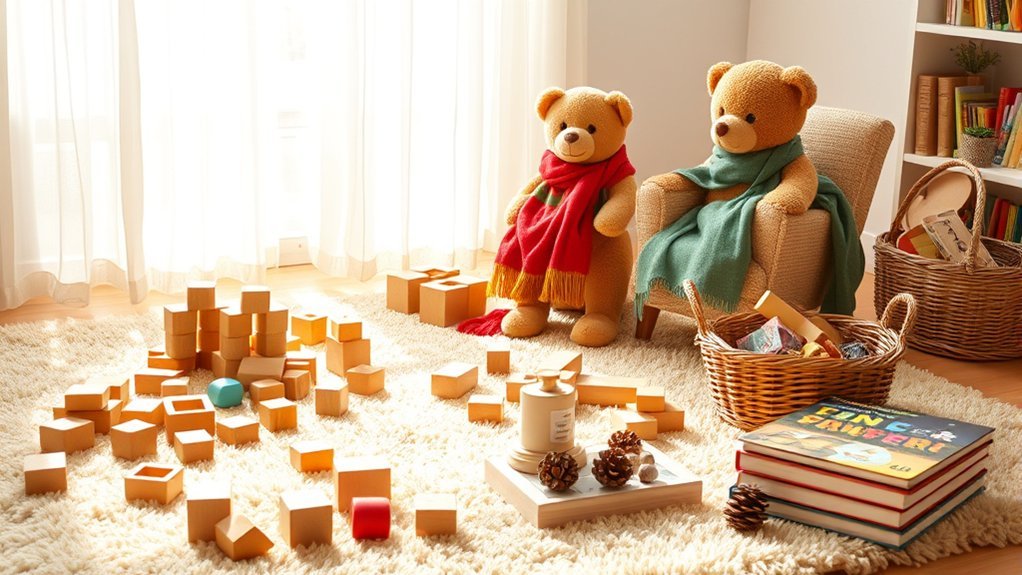Have you ever wondered how the simplest toys can reveal a child’s potential? Open-ended toys offer a unique platform for creativity and skill development. By understanding their benefits and knowing how to select the right ones, you can enhance your child’s play experience dramatically. But what exactly should you consider when choosing these versatile toys? Let’s explore the essential steps to elevate playtime into a powerful learning opportunity.
The Benefits of Open-Ended Toys
When you introduce open-ended toys into your child’s playtime, you’re not just providing them with entertainment; you’re fostering creativity and critical thinking.
These toys encourage imaginative play, allowing your child to explore various scenarios without strict rules. This freedom enhances problem-solving skills as they navigate challenges during play.
Moreover, open-ended toys promote collaboration and communication when children engage with peers, as they negotiate roles and ideas.
You’ll also find that they help develop fine motor skills, as kids manipulate different shapes and materials.
The versatility of these toys means they can adapt to your child’s interests over time, keeping them engaged longer.
Ultimately, open-ended toys cultivate a love for exploration and learning that benefits your child far beyond playtime.
How to Choose the Right Open-Ended Toys
Choosing the right open-ended toys for your child involves considering several key factors that align with their interests and developmental needs.
First, assess their age and developmental stage; toys should be appropriate for their skill level to guarantee engagement without frustration.
Next, think about your child’s interests—whether they’re drawn to building, art, or imaginative play. Opt for toys that encourage creativity and problem-solving, like blocks, art supplies, or loose parts.
Safety is vital, so make certain materials are non-toxic and free from small parts for younger children.
Finally, consider the toy’s versatility; the best open-ended toys can be used in multiple ways, fostering endless exploration and learning.
Tips for Maximizing Playtime With Open-Ended Toys
Once you’ve selected the right open-ended toys, the next step is to maximize their playtime potential. Here are some practical tips to enhance engagement and creativity:
| Strategy | Description |
|---|---|
| Rotate Toys | Switch out toys regularly to keep interest high. |
| Set Up Play Stations | Create different areas for various activities. |
| Encourage Collaboration | Invite friends or siblings to play together. |
| Limit Screen Time | Reduce distractions to promote focused play. |
Creative Play Ideas Using Open-Ended Toys
While open-ended toys provide a versatile foundation for play, your creativity can truly elevate the experience. One idea is to set up a themed adventure, like a pirate treasure hunt. Use blocks to build ships and create maps from paper or fabric.
Open-ended toys spark creativity; transform playtime into a themed adventure like a pirate treasure hunt with blocks and handmade maps.
Another option is to encourage storytelling; combine dolls, action figures, and craft materials to bring tales to life. You could also explore science concepts by constructing simple machines or bridges, challenging your child’s engineering skills.
For artistic expression, provide paints and natural materials, allowing kids to create unique sculptures. Each of these activities not only sparks imagination but also deepens engagement, transforming simple play into a rich learning experience.
Embrace the possibilities that open-ended toys present!
Encouraging Collaboration and Social Skills Through Open-Ended Play
Open-ended play naturally fosters collaboration and social skills among children, allowing them to interact, negotiate, and problem-solve together.
When kids engage in this type of play, they learn to communicate effectively and build meaningful relationships.
Here are a few ways you can encourage collaboration through open-ended toys:
- Promote group activities: Encourage children to work together on projects, enhancing teamwork and collective problem-solving.
- Facilitate discussions: Ask open-ended questions that spark conversations, helping children express their ideas and listen to others.
- Encourage role-playing: Provide scenarios that require children to assume different roles, fostering empathy and understanding.
Frequently Asked Questions
What Age Group Is Best Suited for Open-Ended Toys?
Open-ended toys are best suited for children aged 2 to 8 years. They encourage creativity and problem-solving, allowing kids to explore their imaginations while developing important skills in a fun, engaging way.
Can Open-Ended Toys Be Used for Educational Purposes?
Absolutely, open-ended toys can be educational goldmines! They spark creativity, enhance problem-solving skills, and encourage collaboration. You’ll find your child learning concepts like math and science through imaginative play, making education feel like an adventure.
How Do I Clean and Maintain Open-Ended Toys?
You can clean open-ended toys by wiping them with a damp cloth and mild soap. For maintenance, inspect them regularly for wear and tear, ensuring they remain safe and engaging for your child’s playtime.
Are Open-Ended Toys Safe for Toddlers?
Yes, open-ended toys are generally safe for toddlers. They’re designed with non-toxic materials, but always check for small parts. Supervise playtime to guarantee safety, and watch your child’s creativity blossom as they explore!
Where Can I Find Affordable Open-Ended Toys?
You can find affordable open-ended toys at local thrift stores, online marketplaces like eBay or Facebook Marketplace, and discount retailers. Don’t forget to check community groups for second-hand options that fit your budget!
Conclusion
In the vibrant tapestry of childhood, open-ended toys are the threads that weave creativity, collaboration, and skill development together. By thoughtfully selecting and rotating these versatile tools, you’re not just providing playthings; you’re opening doors to endless possibilities. Encourage your child’s imagination to soar like a kite in the wind, and watch as they cultivate connections with peers and build confidence. Embrace this journey of exploration, and you’ll witness the magic of play unfold before your eyes.
